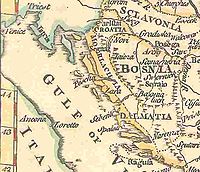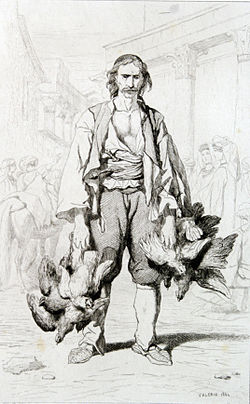This is an old revision of this page, as edited by Zoupan (talk | contribs) at 04:46, 8 June 2014. The present address (URL) is a permanent link to this revision, which may differ significantly from the current revision.
Revision as of 04:46, 8 June 2014 by Zoupan (talk | contribs)(diff) ← Previous revision | Latest revision (diff) | Newer revision → (diff) Not to be confused with Black Wallachia.Morlachs (Croatian and Template:Lang-sr, Serbian Cyrillic: Морлаци) was the name used for the rural population in the Dalmatian hinterlands in the 16th and 17th centuries, which was primarily composed of Eastern Orthodox Serbs, and to a lesser degree Roman Catholic Croats. There were several notable warriors of this group that served the Republic of Venice, including Stojan Janković and Vuk Mandušić.
Etymology
Morlachs is derived from the Italic (Latin) term "Morlacchi". According to some, the etymology is cognate to "Black Vlachs" (from Greek mauro, black). Alberto Fortis theorized that it was derived from Slavic words more (sea) and laci (strong) ("strongmen by the sea").
The historical term "Vlach" was used for anyone who professed the Orthodox faith as opposed to Catholicism. Vlachs, referring to pastoralists, was a common name for Serbs in the Ottoman Empire, Venetian Republic, Habsburg lands, etc.
Origin and culture
The population of the Dinaric highlands, which in the 18th century served as frontiersmen and mercenaries, are generally believed to have migrated from the "Serbian lands", amid and after the Ottoman Empire's conquering of those lands.
Italian Alberto Fortis mentioned the Morlachs in his 1774 work "Put po Dalmaciji"; he found that they sang beautiful verses of Serb epic poetry related to the Turkish occupation of Serbian Kosovo (Kosovo cycle). They sang the verses along with the traditional single stringed instrument called gusle. The poetry was collected by the Scottish man-of-letters Lord Bute, who was close to King George III. Contemporary I. Lovrić, said that the Morlachs were Slavs who spoke better Slavic than the Ragusians (owing to the growing Italianization of the Dalmatian coast). Lovrić made no distinction between the Vlachs/Morlachs and the Dalmatians and Montenegrins that were also mentioned (peoples of Croatia and Slavonia were not mentioned), and was not at all bothered by the fact that the Morlachs were predominantly Orthodox Christian.
Boško Desnica (1886-1945), after analysing Venetian papers, concluded that they always mentioned the script and language of the Morlachs as "Servian".
History

Early history
The term Morlachi is first mentioned in 1352, in the agreement in which Zadar sold salt to the Republic of Venice, in which Zadar retained part of the salt that Morlachi and others exported by land. The Morlachs would thus have extended from the Serbian interior, perhaps from Stari Vlah, towards the Croatian border, in the 14th century. In August 1417, Venetian authorities were concerned with the "Morlachs and other Slavs" from the hinterland, that were a threat to security in Sebenico (Šibenik).
16th century
As many former inhabitants of the Austrian-Ottoman borderland fled northwards or were captured by the Ottoman invaders, they left unpopulated areas. The Austrian Empire encouraged people, mostly Orthodox Serbs from the Ottoman Empire, to settle as free peasant soldiers, establishing the Military Frontiers (Militärgrenze) in 1522 (hence they were known as Grenzers, krajišnici). The militarized frontier would serve as a buffer against Ottoman incursions. The Military frontiers had territory of modern Croatia, Serbia, Romania and Hungary. The colonists were granted small tracts of land, exempted from some obligations, and were to retain a share of all war booty. The Grenzers elected their own captains (vojvode) and magistrates (knezovi). All Orthodox settlers were promised freedom of worship. By 1538, the Croatian and Slavonian Military Frontier were established. Serbs acted as the cordon sanitaire against Ottoman incursions. The Military frontiers are virtually identical to the present Serb settlements in Croatia (war-time Republic of Serbian Krajina).
In 1579, several groups of Morlachs, understood as Serb tribes in Dalmatia, migrated to the Austrian Croatian Military Frontier and requested to be employed as military colonists. Initially, there were some tensions between these and the established Uskoks. In 1593, provveditore generale Cristoforo Valier mentioned three nations constituting the Uskoks, the "natives of Senj, Croatians, and Morlachs from the Turkish parts".
17th century
In the 17th-century, Stojan Janković was one of the Morlach leaders in Dalmatia. In the summer of 1685, Cosmi, the Archbishop of Split, wrote that Stojan had brought 300 families with him to Dalmatia, and also that around Trogir and Split there were 5000 refugees from Turkish lands, without food - seen as a serious threat to the defense of Dalmatia. Grain sent by the Pope proved insufficient, and the Serbs were forced to launch expeditions into Turkish territory.
18th—19th century
In the 1851 census of Dalmatia, the Morlachs, citizens of Ragusa and inhabitants of Dalmatian coast and islands declared themselves Serbs.

Legacy
The population that Venetians called Morlachs were absorbed in the Serbian and Croatian nationalities by the 19th century. According to the 1991 Croatian census, 22 people declared themselves as Morlachs. There was no data on Morlachs in the 2001 Croatian census.
See also
Annotations
- "Vlachs", referring to pastoralists, was a common name for Serbs in the Ottoman Empire and later. Tihomir Đorđević points to the already known fact that the name 'Vlach' didn't only refer to genuine Vlachs or Serbs but also to cattle breeders in general. A letter of Emperor Ferdinand, sent on November 6, 1538, to Croatian ban Petar Keglević, in which he wrote "Captains and dukes of the Rasians, or the Serbs, or the Vlachs, who usually call themselves the Serbs". Serbs that took refuge in the Habsburg Krajina, were called "Vlachs" by Croats. In the work "About the Vlachs" from 1806, Metropolitan Stevan Stratimirović states that Roman Catholics from Croatia and Slavonia scornfully used the name 'Vlach' for "the Slovenians (Slavs) and Serbs, who are of our, Eastern confession (Orthodoxy)", and that "the Turks in Bosnia and Serbia also call every Bosnian or Serbian Christian a Vlach" (T. Đorđević, 1984:110). That the name 'Vlach' was used to signify the Serbs is testified by Vuk Karadžić as well.
References
- ^ Fine 2006, pp. 360-361
- ^ Imagology. p. 235. ISBN 9042023171.
- Fine 2006
- Listine o odnošajih Južnoga Slavenstva i Mletačke Republike. Vol. III. Zagreb: JAZU. 1872. p. 237.
Prvi se put spominje ime »Morlak« (Morlachi) 1352 godine, 24. lipnja, u pogodbi po kojoj zadarsko vijeće prodaje sol Veneciji, gdje Zadar zadržava dio soli koju Morlaci i drugi izvoze, kopnenim putem.
- THE ENCYCLOPEDAEDIA BRITANNICA. 1929. p. 230.
- Fine 2006, p. 115
- William Safran, The secular and the sacred: nation, religion, and politics, p. 169
- Nicholas J. Miller, 1998, Between Nation and State: Serbian Politics in Croatia Before the First World War, p. 10
- Gunther Erich Rothenberg (1960). The Austrian military border in Croatia, 1522-1747. University of Illinois Press. p. 50.
- Fine 2006, p. 218
- ^ Ivan Ninić. Migrations in Balkan history. p. 80.
- Mile Dakić (1994). The Serbian Krayina: Historical Roots and Its Birth. Iskra. p. 12.
- Croatian 2001 census, detailed classification by nationality
- ^ (Document). 2003.
{{cite document}}: Cite document requires|publisher=(help); Missing or empty|title=(help); Unknown parameter|url=ignored (help)
Sources
- John Van Antwerp Fine (2006). When ethnicity did not matter in the Balkans. ISBN 0472025600.
- Norman M. Naimark; Holly Case (2003). Yugoslavia and Its Historians: Understanding the Balkan Wars of the 1990s. Stanford University Press. pp. 38–. ISBN 978-0-8047-4594-9.
External links
- Encyclopaedia Britannica (1911). "Dalmatia".